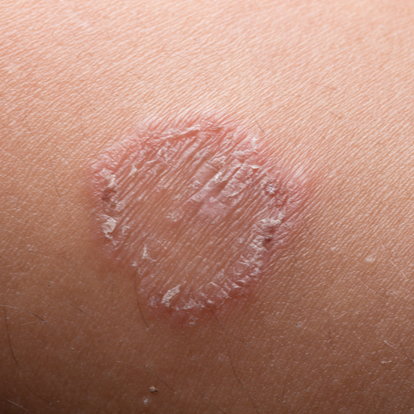 OVERVIEW
OVERVIEW
There are many different types of fungal infections that can affect your skin. One of the most common types is Ringworm or Tinea Corporis. This condition impacts several people, but fortunately, there are treatment options that can help curb the symptoms.
What is Ringworm?
Ringworm d is a rash caused by a fungal infection. The main symptom of Ringworm is itchiness and circular rash with clear and unblemished skin in the middle. Ringworm received its name because of the circular shape of the rash, and contrary to popular belief, it has no association with worms at all.
Ringworm that affects the scalp area can start as a bump or small sore and turn flaky and scaly. This can lead your scalp to feel sore and tender to the touch. In severe cases, your hair will fall out in patches, which a Ringworm infection can cause.
If somebody is suffering from Ringworm, it can be related to Athlete’s Foot or tinea pedis, jock itch or tinea cruris, and the scalp area or tinea capitis. It can quickly spread with skin-to-skin contact with either an infected person or animal.
Common Symptoms of Ringworm
- Overlapping rings
- Itchiness
- The scaly ring-shaped area can show up in the trunk, arms, legs, and buttocks
- The inside of the ring is characterized by either a smooth or scaly area. There can be bumps inside the ring which are white or reddish.
- The rings are raised and slightly expanded
- A round, flat patch of itchy skin
Ringworm is a contagious infection caused by common mold-like parasites on the cells found on the outer layer of the skin. It can spread from human-to-human, animal-to-human, object-to-human, and even soil-to-human.
How is Ringworm diagnosed?
Ringworm is often easily diagnosable by visual inspection of the affected area. If the infection is severe, your doctor might opt to have skin scrapings taken from the area and examined under a microscope.
You should contact your dermatologist if you suspect you have Ringworm because it can be confused with other skin conditions. Getting a proper diagnosis is important to be placed on the correct treatment plan.
Common Treatments for Ringworm
If you are suffering from Ringworm, a topical or over-the-counter treatment will be used. If this doesn’t help, you will need a prescription-strength lotion, cream, or ointment. If Ringworm doesn’t get better with creams, your doctor might prescribe antifungal pills.
Ointments used to treat Ringworm have to be placed on your skin for 2 to 4 weeks to ensure that the fungus is killed and eradicated. This will lower the chances of Ringworm coming back. It is usual for Ringworm to start harmless, but it will turn into a bigger problem if left untreated and undiagnosed.
In less severe cases of Ringworm, you can try to perform self-care at home by keeping the impacted skin dry and clean at all times. You can apply over-the-counter antifungal creams such as Lotrimin AF (clotrimazole) or Lamisil AT (terbinafine).

